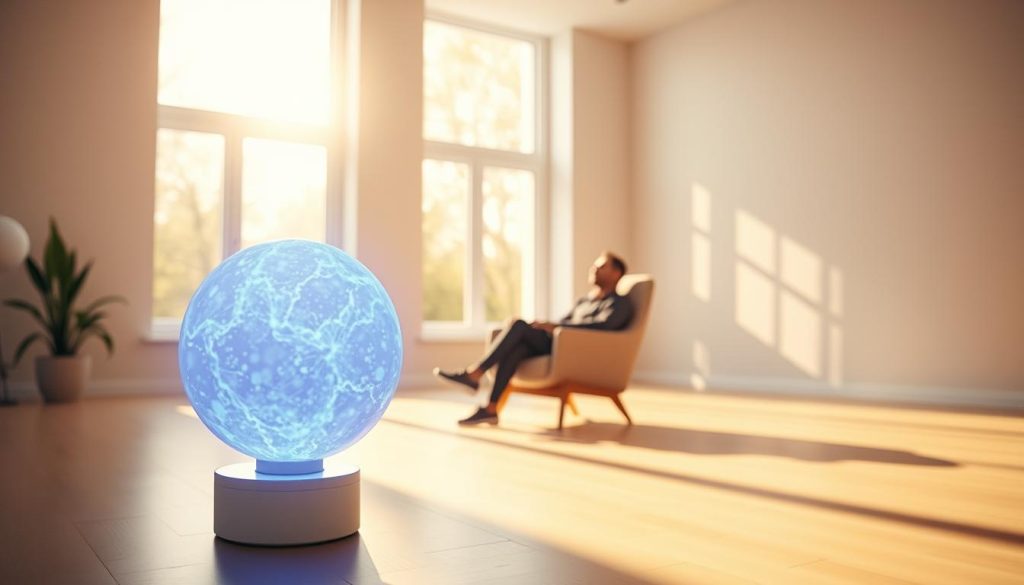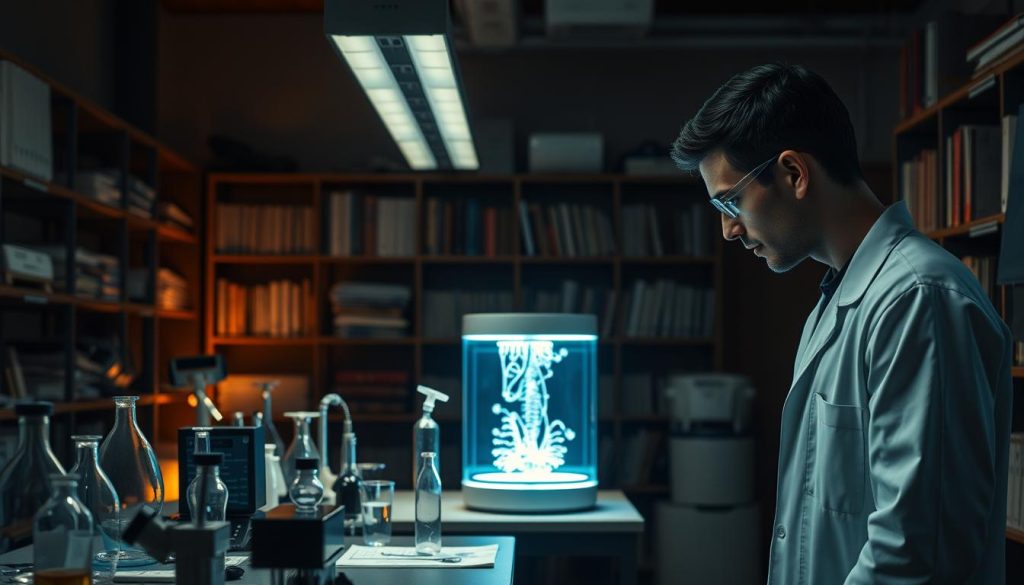Negative ion research has become very popular lately. It has caught the eye of scientists and health fans. This field looks into how these tiny particles might help our health.
Many people are curious and a bit skeptical about these claims. It’s important to look at the scientific proof. This article will share the latest research on negative ions. We’ll explore how they might improve our health.
Introduction to Negative Ions
Negative ions are tiny molecules with a negative charge. They are found in nature, like forests, waterfalls, and oceans. These ions have an extra electron, making them negative. Scientists and health fans are interested in their effects on our bodies.
Negative ions are everywhere, but in different amounts. Places like beaches and mountains have more of them. This is why people often feel refreshed there. But, our homes with lots of electronics have fewer negative ions.
Studies show negative ions might help our bodies in many ways. They could improve our mood and mental focus. This is because they might raise serotonin levels, helping us feel better and less anxious.
Exploring negative ions is important. We need to know about their natural presence and health effects. With this knowledge, we can better understand their role in our lives.
What Are Negative Ions?
Negative ions have more electrons than protons, giving them a negative charge. They are found naturally in places like forests, waterfalls, and beaches. This is because water and air movement break molecules apart, releasing ions.
Scientists also create negative ions artificially. They use this technology to explore their health benefits.

Unlike positive ions, which are linked to pollution, negative ions are thought to improve air quality. They can attach to pollutants, making the air cleaner. This helps our lungs breathe easier.
Research also shows that negative ions can make us feel better. They can lift our mood, reduce stress, and improve our overall health.
| Characteristic | Negative Ions | Positive Ions |
|---|---|---|
| Charge | Negative | Positive |
| Source | Nature (e.g., waterfalls, forests) | Pollution, electronic devices |
| Health Effects | Promotes well-being, improves air quality | Can contribute to allergies and stress |
Understanding negative ions helps us see their value in health and well-being. Whether they occur naturally or are made through technology, they have great potential. They can make our living spaces better and improve our health.
Negative Ion Research Studies
Negative ion research has been key in understanding their health benefits. Scientists have used many methods, from lab tests to field studies. They aim to see how negative ions affect our health.
A study by Columbia University looked at negative ions and mood. They found that negative ions can make people feel better and reduce depression symptoms.
Research also focuses on how negative ions help our breathing. The Journal of Epidemiology found that more negative ions can ease asthma and allergy symptoms. This is because negative ions clean the air, removing harmful particles and allergens.
Studies also show that negative ions can boost our brain power. The Mayo Clinic found that being around more negative ions can improve our focus and mental clarity. People in areas with more negative ions did better on mental tests than those in areas with fewer.
Even though some scientists are still unsure, the evidence keeps growing. It shows that negative ions might have a big role in keeping us healthy. More research is needed to fully grasp their benefits.
A table below shows some important studies:
| Study | Focus Area | Key Findings |
|---|---|---|
| Columbia University | Mood Regulation | Improvement in mood and reduction in depression symptoms |
| Journal of Epidemiology | Respiratory Health | Alleviation of asthma and allergy symptoms |
| Mayo Clinic | Cognitive Function | Enhancement of mental performance and concentration |
How Negative Ions Impact the Body
Negative ions are tiny particles that might help our health. They’re found in places like mountains, forests, and waterfalls. This section will look at how they affect our breathing and mood.
Effects on the Respiratory System
Studies show negative ions can boost our breathing health. They help increase oxygen in our blood. This is good for people with asthma and COPD.
Being around negative ions can clean our airways. It also reduces swelling and improves lung function.

Influence on Mood and Mental Health
Negative ions might also improve our mood and mental health. They can raise serotonin levels, which makes us feel happier. This can help lower depression and anxiety.
Research is still going on, but early results are good. For example, a study by Columbia University found negative ions can make us feel better and help with SAD. Here’s a table with some of the mood benefits of negative ions:
| Study | Outcome |
|---|---|
| Columbia University | Improvement in SAD symptoms |
| University of California | Increased serotonin levels |
| Swiss Research Institute | Reduction in anxiety levels |
Looking at how negative ions affect our breathing and mood, it’s clear they have a big impact. They offer a natural way to improve our health and happiness.
Health Benefits of Negative Ions
Negative ions are found in nature and are key for well-being. They are electrically charged particles that offer health benefits. This makes them interesting for wellness studies.
Negative ions can reduce stress. Studies show they lower cortisol levels, the stress hormone. This leads to calmness and better mental focus.
They also boost energy. Being near waterfalls or forests, where negative ions are plentiful, makes you feel more alive. This encourages more activity and better energy.
Negative ions may help with health issues too. People with SAD or depression feel better after being around them. They might help increase serotonin, which makes us happy.
The use of negative ions for wellness is growing. They help with stress, boost energy, and may help with mood disorders. This makes them a promising way to improve health and well-being.
| Health Benefit | Supporting Evidence |
|---|---|
| Reduced Stress | Lower cortisol levels; increased mental clarity |
| Increased Energy | More invigorated feeling; enhanced vitality |
| Improved Mood | Higher serotonin levels; relief from depression and SAD symptoms |
More research is needed, but negative ions are getting a lot of attention. They are seen as a way to improve wellness by health enthusiasts and researchers.
Scientific Studies on Negative Ions and Their Benefits
In recent years, there’s been a growing interest in negative ions. Scientific studies on negative ions have shown they can positively affect our health. This section will explore some key research that highlights their benefits.
A study by Columbia University looked into how negative ions affect our mood. It found that people exposed to more negative ions felt less depressed. This supports the idea that negative ions can increase serotonin, improving our mood and mental health.
In Japan, researchers studied negative ions and their impact on breathing. They discovered that negative ions can reduce airborne allergens. This is good news for people with asthma or allergies. These findings suggest negative ions could be used to help with breathing problems.
A German study also looked into negative ions and brain function. It showed that negative ions can improve mental clarity and focus. The study found better test scores and concentration, showing negative ions can boost our brain power.
The results from these scientific studies on negative ions are very promising. They show the wide range of health benefits they offer. This research opens doors for more studies, aiming to fully understand the benefits of negative ions for our health.
Negative Ions for Wellness
In recent years, the wellness community has welcomed negative ions. They are thought to improve both physical and mental health. This makes them key in holistic wellness.
Improved Sleep Quality
Research shows negative ions can help sleep better. They boost serotonin in the brain. This leads to deeper and more restful sleep.
Enhanced Immune Function
Studies also show negative ions boost the immune system. They increase immune cell activity. This helps the body fight off infections better. The science on negative ion benefits is growing, showing their value in wellness.
Negative Ion Therapy Research
Negative ion therapy research has grown, focusing on its use in hospitals. It aims to understand its benefits fully.
Clinical Applications
Medical centers use negative ion therapy to help patients get better. Research shows it can make treatment rooms better for healing. Doctors use negative ion generators to help with Seasonal Affective Disorder, chronic fatigue, and some lung problems.
Patient Testimonials
People who tried negative ion therapy share their stories. They talk about feeling more energetic, clear-minded, and happy. Those with lung issues say they breathe better and have fewer symptoms after using negative ions.

The Role of Negative Ion Technology in Modern Health
In today’s world, negative ion technology research is key in making health devices better. These devices use negative ions to help us stay healthy. They range from air purifiers to wearable tech that boosts our well-being.
Air purifiers with negative ion tech are getting more popular. They clean the air in our homes by removing pollutants and allergens. This tech helps keep our air clean and improves our breathing.
Wearable tech, like wristbands and necklaces, also uses negative ion tech. They help manage stress and improve our health. These gadgets release negative ions that might help balance our energy and mood.
Research on negative ion technology is ongoing. It shows promise for making our daily devices healthier. This tech is not just a trend; it’s a big step towards a healthier life.
Negative Ion Effects on Allergies and Asthma
Negative ion research shows how they can help with breathing problems. These tiny particles might clean the air by getting rid of pollutants. This can help people with allergies and asthma breathe better.
Many studies have looked into how negative ions can help with allergies and asthma. They found that being around negative ions can lower the amount of allergens in the air. This means fewer things can trigger allergies. For people with asthma, negative ions might make it easier to breathe by opening up airways.
Also, people who have tried negative ions say they feel better. They report having fewer allergy attacks and less trouble breathing with asthma. This is when they are in places with lots of negative ions.
To sum it up, let’s look at a comparison:
| Aspect | Allergies | Asthma |
|---|---|---|
| Symptom Reduction | Decreased allergen sensitivity | Improved airway function |
| Air Quality | Lower allergen load | Cleaner breathing air |
| Patient Feedback | Fewer allergy attacks | Reduced asthma symptoms |
Research on negative ions keeps showing they might help with breathing problems. They can make the air cleaner by removing pollutants. This could be a good way to help people with allergies and asthma feel better.
Future Directions for Negative Ion Research
The study of negative ions is growing fast. Researchers are excited to learn more about how these particles can help us. They want to know how negative ions work with our cells.
This knowledge could lead to new ways to prevent and treat diseases. It could make negative ions even more important in medicine.
New studies will look at using negative ions in different places. This includes homes and hospitals. With new tech, using negative ions could become easier and more effective.
Hospitals might use negative ion generators more often. This is because clean air is key for patients, whether they’re recovering or managing chronic diseases.
But, there’s still a lot to learn. We don’t know the best amount of negative ions for each health issue. We also need to study their long-term effects.
By answering these questions, scientists can help us use negative ions better. This could improve our health in big ways.

